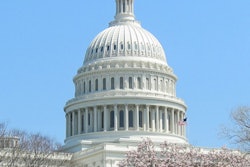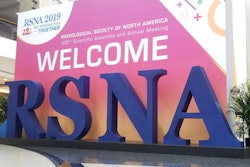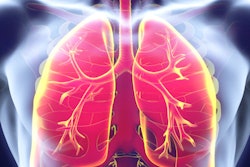
SAN DIEGO - As CT lung cancer screening continues to expand across the U.S., what measures can healthcare providers take to ensure that screening programs remain efficient, cost-effective, and patient-centered? Dr. Florian Fintelmann offered 10 tips in a talk at the 2019 International Society for Computed Tomography (ISCT) meeting.
"Lung cancer screening is not just a single exam -- it's a process," he told ISCT attendees. Fintelmann is a staff radiologist at Massachusetts General Hospital and an assistant professor of radiology at Harvard Medical School.
Most CT lung cancer screening programs involve collaboration among a variety of individuals, from radiologists and referring providers to patient navigators and hospital administrators, he continued. You need all of these experts and providers to buy in to the program for it to be successful.
Sound foundation
Recent estimates for participation in CT lung cancer screening hover at approximately 10% of the eligible population in the U.S., suggesting an upward trend in uptake, Fintelmann noted. Yet many challenges remain for more widespread implementation of screening, including properly addressing skepticism and improving access.
"As of today, the American Association of Family Physicians is still on the fence about whether CT lung cancer screening is actually a good thing; [the organization] has suggested there is insufficient data to conclude that it is helpful," he said. "So a lot of times, that's where you'll find doubters that may need reminders about eligibility."
Fintelmann and colleagues first presented their model for an organized, stepwise approach to setting up CT lung screening programs in a 2015 publication (Radiographics, November-December 2015, Vol. 35:7, pp. 1893-1908).
At ISCT 2019, Fintelmann detailed his team's 10 pillars of lung cancer screening and also provided an update to their initial work on the topic.
- Education: A relatively new strategy for promoting CT lung cancer screening programs has been to develop a digital awareness campaign. Clinicians at Massachusetts General Hospital recently began targeting potentially eligible individuals through Facebook, Google, and Twitter. They found that this effort has led to a significant increase in the number of referrals for screening at their institution.
- Eligibility: The U.S. Centers for Medicare and Medicaid Services (CMS) offers reimbursement for annual CT lung cancer screening only if participants meet specific eligibility criteria, including being between 55 and 77 years and having a smoking history of at least 30 pack years with 15 or fewer years since cessation. These criteria have not changed.
- Exam ordering: For reimbursement, CMS also requires that ordering physicians confirm that participants are willing and able to undergo diagnosis and treatment of lung cancer. The website ShouldIScreen.com is a tool that radiologists can share with referring physicians to send to patients so that they can review information about screening at home.
- Image acquisition: The gold standard is to acquire noncontrast CT scans with a CTDIvol radiation dose of no more than 3 mGy. Another important setting to note is the requirement of a slice thickness of 2.5 mm or less, with a 1-mm thickness interval. It is very difficult to ascertain the precise attenuation of nodules, or if a ground-glass nodule has developed a solid component, when using a slice thickness of 5 mm.
The American Association of Physicists in Medicine offers low-dose chest CT protocols that include full specifications for best-practice lung cancer screening for free. - Image review: CMS also has requirements for radiologists who can request reimbursement for reviewing CT lung cancer screening scans, including being board-certified, trained in diagnostic radiology and radiation safety, and involved in the supervision and interpretation of at least 300 chest CT scans in the past three years.
- Communication: Another requirement by CMS is that readers use a standardized lung nodule identification, classification, and reporting system. Of note, the American College of Radiology (ACR) this year revised its Lung-RADS reporting tool, now at version 1.1.
- Referral network: Very high-risk individuals, such as those who are categorized as Lung-RADS 4, are sent to nodule management experts. Lower-risk individuals, such as those categorized as Lung-RADS 1-3, are sent back to the referring physician for follow-up.
The most important aspect of having an established referral network is to promote smoking cessation, which, in and by itself, is much more cost-efficient than undergoing CT lung cancer screening and additional workup, Fintelmann said. A recent study reported that roughly 11 opportunities are available to present smoking cessation interventions throughout the lung cancer screening process. - Quality improvement: Screening programs should submit their data to the ACR registry for all lung cancer screening cases and register reading radiologists. It is also helpful to have a steering committee to review local outcomes, including patient adherence, costs, and satisfaction.
- Reimbursement: It is important to encourage referring physicians by providing them with handouts or other information they may need, since reimbursement for shared decision-making is currently very low (roughly $30). Furthermore, radiologists should make an effort to confirm that the referring physician has documented completion of a shared decision-making session with the patient, or otherwise risk not receiving reimbursement.
"CT lung screening is the only screening exam I can think of where we're on the hook, even after we have performed and interpreted the scan and done the reading, where we risk still not getting paid," Fintelmann said. - Future research: Various groups have developed risk-prediction models that can help personalize lung cancer screening, and several of these models have demonstrated a potential to improve the efficiency of screening. Other investigators have also explored the possibility of using machine-learning algorithms to facilitate image interpretation.




















